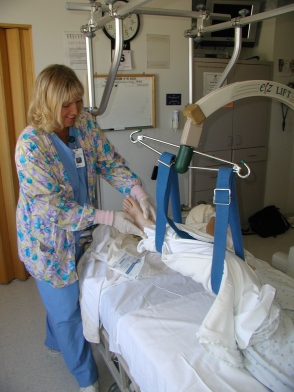Sept. 18 webinar — Care Coordination & the Essential Role of Nursing
Monthly Archives: August 2013
Patient satisfaction is easy. Talk to a nurse.
 Hospitals are bending over backward to increase their patient satisfaction scores, and, especially now, as it may affect their ability to bill patients. Hospitals are adding room service, suites, and even “care guides” to help patients meet health and recovery goals.
Hospitals are bending over backward to increase their patient satisfaction scores, and, especially now, as it may affect their ability to bill patients. Hospitals are adding room service, suites, and even “care guides” to help patients meet health and recovery goals.
The answer to patient satisfaction isn’t a new piano in the lobby, it’s right inside each patient’s room. It’s the nurse. Nurses say they’re often asked, “can you just sit with me a while?” by a patient. Or the patient will even ask a nurse who’s charting if he or she can just turn around and face them while they have to also look at the computer. It’s the caregiver interaction that patients need and, yes, crave when they’re vulnerable, and it’s the one-to-one contact that will make patients happy.
Some hospitals seem to get it. Sort of. One hospital just boasted that it had increased nurse-to-patient contact time by double-digit percentages as a show of progress, but what this hospital didn’t mention is that they did it by moving computers into patient rooms so nurses had to chart while sitting next to a patient, not with a patient. That’s called abiding by the letter of the law but not the spirit.
Other hospitals, however, continue to understaff nurses in critical areas. Even where a nurse needs to watch over a patient, comfort then, or explain how their care will continue at home, nurses are shaving time with each patient so they can get to the next. A nurse blazing through discharge instructions doesn’t make patients feel satisfied or cared for, it just makes them feel like a number.
Rather than poll patients to determine their satisfaction, hospitals ought to be keeping track of how many patients each nurse is spending time with. That’s the simple and effective formula for figuring patient satisfaction.
When No One is On Call
Bravo to Theresa Brown, RN, for writing an eye-opening Op-Ed, exposing the dangers faced by patients when not enough nurses are on duty. The New York Times published her opinion on Sun., Aug. 18, which puts this issue front and center, where it should be. Read the OpEd here.
We encourage you to read the entire piece, along with the Comments Section AND participate in the online discussion.
Brown mentions only one piece of legislation being considered by Congress to address the issue of poor staffing levels, but it is important to know that efforts are being led by nursing communities (including National Nurses United) to advance other bills on the federal and state levels as well.
In April of this year, U.S. Sen. Barbara Boxer (D-CA), introduced the National Nursing Shortage Reform and Patient Advocacy Act, (S 739) and its companion bill in the House, authored by Rep. Jan Schakowsky, Safe Nurse Staffing for Patient Safety and Quality Care Act (HR 1907).
If passed, the legislation would protect the rights of nurses to advocate on behalf of their patients, establish minimum nurse-to-patient ratios in hospitals and invest in training and retaining nurses to address the nationwide nursing shortage.
“I am proud to introduce legislation that will help save the lives of countless patients by improving the quality of care in our nation’s hospitals,” Sen. Boxer says. “We must support the nurses who work tirelessly every day to provide the best possible care to their patients.”
Specifically, Boxer’s bill would:
- Establish minimum nurse-to-patient ratios that will save lives, improve the quality of care and help to address the nursing shortage by creating a work environment that encourages nurses to remain in the hospital workforce.
- Provide whistleblower protections to protect the right of nurses to advocate for the safety of patients and report violations of minimum standards of care.
- Invest in nursing mentorship demonstration programs to better prepare nurses for work in a hospital setting.
Call for Applications for the Nursing Administration: Scope and Standards of Practice Revision Workgroup
Medicare Primary Care Incentive Program Awards Announced for 2012
NNU Joins National Action to Reclaim MLK’s Dream
Commemorative March for the 50th Anniversary of Dr. Martin Luther King, Jr’s March for Jobs and Freedom (Where he delivered his “I Have a Dream” speech.)
Saturday, August 24 in Washington, DC (one week from today!)
Fifty years ago, hundreds of thousands of activists gathered in Washington, DC to fight for an end to poverty and racism in America. Fifty years later, America still needs our help to heal the wounds of inequality and injustice. Join us for a rally and commemorative march along MLK’s historic 1963 route to bring the Main Street Contract and the call for living wage jobs, equal access to quality education, guaranteed healthcare, a secure retirement, clean and safe housing and a fair taxation system to Congress and the President.
If you can, please join us!
Meet at 9:30 a.m. at the Albert Einstein Memorial (corner of 22nd St. and Constitution Ave NW).
After gathering there we will join other activists at the Lincoln Memorial for a rally program and then march united to the MLK Memorial.
Wear red scrubs if you have them. If not, anything red will do.
- Download and share the Dream Actioin Flyer
- Share the Facebook Dream Action Event Page
- Also, check out this free RN CE class coming soon to the DC area
We look forward to seeing you in DC,
Deborah Burger & Jean Ross
Proud Registered Nurses
NNU co-pressidents
Staff Staffing Video Update
Representative Mauree Gingrich (R-101) has introduced non-ratio safe staffing legislation, House Bill 1631. Watch our video update for details on this important bill.
